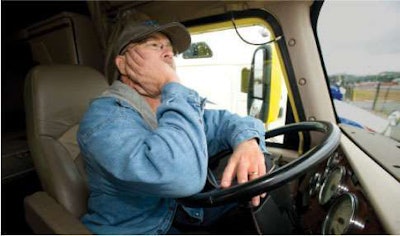 FMCSA’s Medical Review Board and Motor Carrier Safety Advisory Committee officially approved recommendations regarding sleep apnea screening for truck drivers. Some criteria would automatically disqualify drivers from receiving their medical certification, while others would allow drivers to receive conditional certification, pending a sleep study and treatment of sleep apnea should they be diagnosed.
FMCSA’s Medical Review Board and Motor Carrier Safety Advisory Committee officially approved recommendations regarding sleep apnea screening for truck drivers. Some criteria would automatically disqualify drivers from receiving their medical certification, while others would allow drivers to receive conditional certification, pending a sleep study and treatment of sleep apnea should they be diagnosed.Two FMCSA advisory committees this week stamped their approval on recommendations to the agency regarding which truck drivers should be screened for obstructive sleep apnea before being cleared to drive.
The final version of the recommendations retains the conditional criteria to refer drivers for sleep apnea testing, based mostly around their BMI and other factors that could indicate obstructive sleep apnea. FMCSA’s Medical Review Board and its Motor Carrier Safety Advisory Committee voted to approve the recommendations Tuesday, Oct. 25.
Truck operators with a Body Mass Index of 40 or higher would be flagged for sleep apnea screening if the recommendations are made law. Those truckers would receive a 90-day medical certification, during which time they must have an in-lab sleep study. If diagnosed with obstructive sleep apnea, they would need to begin treatment within the 90-day period.
Truckers with a BMI of 33 or higher would also be subject to screening if they meet three other qualifiers, a list that includes being male and being older than 42 — a large demographic in the trucking industry. Such drivers would receive the same 90-day certification aforementioned and must receive an in-lab sleep study during that time.
Male truckers age 42 and older who have a BMI of 33 or greater would be flagged for a sleep test if they also have high blood pressure, have diabetes, have history of heart disease, snore loudly, have witnessed apneas or have a neck size greater than 17 inches, among other qualifiers.
Drivers diagnosed with moderate to severe obstructive sleep apnea could receive a medical certification from their examiner that lasts no longer than a year, rather than the standard two-year certification.
The Oct. 25-finalized recommendations are simply recommendations and bear no legal weight. However, FMCSA likely will lean heavily on the criteria when developing a sleep apnea screening rule.
Notable changes to the final document approved Oct. 25 center on the immediate disqualification criteria. Truckers who meet the following would be immediately disqualified from driving by their medical examiner and would be referred for a sleep test:
- Report excessive sleepiness while driving
- Experience a crash associated with falling asleep
- Been observed sleeping behind the wheel while operating the vehicle
- Found non-compliant with proper treatment of existing obstructive sleep apnea
The recommendations would also give medical examiners the discretion to “disqualify any driver who appears to be extremely high risk,” according to the document.
Truckers sidelined by the immediate disqualifications would remain out of service until they begin treatment for apnea. Per the recommendations, truckers would need to be treated for two weeks to requalify to drive. They would then receive a 90-day certification.
Treatment options included in the committee recommendations include the use of a continuous positive airway pressure machine and various surgeries intended to treat the condition.
Testing options include both in-lab and at-home tests, but a certified sleep specialist must review the findings from either test. Medical examiners must then sign off on the diagnosis, too.
Below is the full list of conditional criteria spelled out by the FMCSA committees. If a driver has a BMI of 33 or higher and meets three of the following, he or she would be referred for sleep apnea:
- older than 42
- is male or postmenopausal female
- has diabetes, has high blood pressure
- has a neck size greater than 17 inches (males) or 15.5 inches (females)
- has a history of heart disease
- snores loudly
- has witnessed apneas
- has a small airway
- has untreated hypothyroidism, or
- has micrognathia or retrognathia












